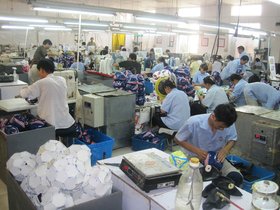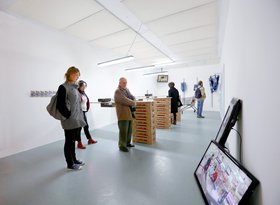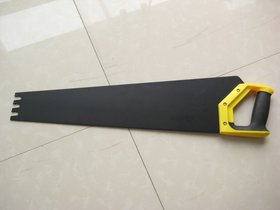Interviews
Errant Propositions
Jeremy Hutchison in conversation with Natasha Hoare
Jeremy Hutchison's work often explores the absurdity of the everyday, a strategy employed to make visible power structures inherent to global flows of production, while offering disruptive proposals for alternative situations. His work Err (2011) earned widespread recognition and comprised of a series of commissioned 'incorrect' versions of objects factory workers produce everyday: (the workers were invited to 'design' the malfunction). Hutchison has made work in different global contexts, including the West Bank, Palestine, where he recently completed a 3 month residency as part of a Delfina Foundation and ArtSchool Palestine residency series between London and Ramallah. Whilst in Palestine, he created the installation Fabrications (2013), which combines a number of interventions staged during the residency. It will be shown as part of an exhibition, Points of Departure (2012), which will be showing at the Institute of Contemporary Art in London from 26th June to 21st July 2013.
Natasha Hoare: You recently completed a residency in Ramallah with Delfina Foundation and took part in the exhibition Points of Departure (2013), which will be part of the Shubbak festival at the ICA in London this summer. How was the residency and can you tell me about the work you made as a result of having been there?
Jeremy Hutchison: When you go to the Middle East, one thing I am struck by is the head on clashing of two very different modes of rationality; neither of which I am more or less partisan to. But what it does make me think about is the construction of rationality and how our codes of logic and reason are fabricated according to our own sense of history and politics. So I made an installation called Fabrications (2013), which consists of a series of interventions in mass production and commercial industrial contexts. For one of these interventions I invited the employees of a supermarket to perform their ordinary functions backwards. So all the shelf stackers un-stacked shelves, all the till operators gave money to customers and unpacked their bags, and everyone walked backwards. At the jeans factory in Nablus on the West Bank, I invited them to create jeans that expressed what it was like to create jeans in Nablus, bearing in mind that they had gone to work every day with the barrel of an Israeli tank pointed at their factory. One might imagine the stress that this would engender. So inevitably, the jeans are all unwearable and grotesque. With the installation I was trying to suggest that there are always infinite alternative codes of logic, some of which seem absurd to us but might not to someone else.
NH: How did they respond to your intervention?
JH: They all behaved differently. There was another project where I worked with workers in a peanut factory. I asked them to do all their repetitive functions: sorting the half nuts and whole nuts, sugaring, baking and putting them in packets, but without any nuts. So we were filming this performance of labour. This factory is right at the heart of problems and most of the workers had been to jail, as many in the region have, and so for them it was a radical political gesture. They knew I was an artist and they did it because it was a subversion. The jeans factory guys really wanted to tell me their story. They used to sell to Marks & Spencer and Levis, but they had their supply line cut, so it was very intense with them. Making the jeans was a bit of a by-product, something that happened alongside these ongoing conversations. It wasn't a carnival for them; in the supermarket it was more of a carnivalesque moment playing out, but there is always this idea of the constructed carnival, itself arguably impotent as it allows a moment of chaos, only for you to flip back.
NH: Modes of display seem to be central to your practice, as was made so evident with Erratum (2013) at Paradise Row, London. How is this curatorial approach important?
JH: It's important because my activity as an artist is almost like a creative director managing performances more than making work or objects. So I think curating is a really good way of describing it. In my work I am interested in the overlapping of industry and art. Both my studio and installations are often infused with a crossover between the industrial space and the commercial space.
NH: The theme of the Points of Departure exhibition was around the anthropological concept of 'liminality'. How did you work with this concept?
JH: I guess the liminal zone is a site of possibility and potentiality, and my role as an artist is to develop proposals as to the way things could be in a parallel universe. So I am interested in liminality and how it intersects with humour and absurdity. The mediaeval carnival is something of great importance to me as a moment in which the world is spun upside-down, where the wise man becomes a fool, and for a couple days anything goes. It is a second world invading a world governed by strict codes and dogma.
NH: Did you find a carnivalesque tradition in the Ramallah region?
JH: In some ways, yes. The carnivalesque emerged owing to the dominance of the state and Church; a binary parallel and subversive element emerges from this dominance. I think that is very true of Palestine. What I love about Palestinians is their deviant sense of humour, their miscreant will to survive and will to carry on regardless of the fact that they have to crawl through sewage pipes to see their families and get sprayed with feces by the Israeli army. My experience is that they identify with that irreverence, and the opportunity to subvert for genuine political ends. I think that's what a lot of the Palestinian identity is built around, because you have to find a way to survive.
NH: Liminality implies a kind of generative state of disorientation: is this a fitting description for residencies in general?
JH: Yes, and artistic practices, and fatherhood! I think disorientation is very important. We can relate to the idea of being inspired by not understanding what we are looking at, it dislodges something in your brain. By going on a residency and dislodging all your assumptions you can find yourself in freefall in a really productive way. From a linguistic stand point I always find that this teasing apart can be achieved through repetition of a word, a process that dislodges and disorients your association with it.
NH: The idea of disorientation is itself a strong one in your work, especially some earlier pieces such as Stop/Go (2010) and Please Take One/Please do Not Touch (2011). Do you consider disorientation to be a positive state?
JH: Yes, definitely. I think really bad things happen when we pin human existence to clear ideologies, when we know or think we know what truth is, or what happiness is really generated by. Those things always end in death camps and gulags.
I had a moment with Robert Smithson's Islands of Broken Glass (1970), it's a big floor piece, and there is that feeling of subjectivity being shattered in the artwork and your relationship to the form, and therefore of your self, being constantly mitigated as you move around it. So a work like that literally performs that sense. And good work does bring you in and seduces you so that you give a damn, and once you are in you lose yourself and the understanding of the piece, and this all falls away in a vortex.
NH: You have made work in the West Bank and Jerusalem previously. What is it that draws you to the region?
JH: The fact that really for a white western male, nothing there really makes sense. It is truly ungraspable. They all are Semites but make anti-Semitic slurs against one another. There is this clashing of logic, and within that something interesting happens to make dogged logic suddenly look so absurd. I am interested in places in which I am somehow imbricated. My great uncle was in the British army during the Arab Uprising. I think we are all somehow embedded in this problem. So I find it an interesting place to be as a tourist. I perform the tourist because I think the tourist gives you the opportunity to ask basic questions. When you really perform it you can cycle into walls because you don't see them, you don't know what the problems are and you can push that ignorance. I think children are particularly productive agents in these spaces. I was trying to find a way to come at this, which doesn't undermine its gravity; to ask a thousand wrong questions so that one that is valuable might come out.
NH: It's a very weighty context to be stepping into and it's interesting that you employ the tourist as a strategy to deal with that weight. You have irresponsibility as a tourist, you're allowed a level of idiocy and disengagement.
JH: Yes, I've just finished reading Dostoevsky's The Idiot, which is about a Russian Prince who doesn't understand anything about Russian society. And people loathe him but simultaneously adore him. Idiocy is a really interesting thing to bring into any context. We are always performing some role, and that's the one I worked with.
NH: Your work responds to the effects of globalization on labor. Do you seek to deconstruct the effects of post-Fordism through giving the workers you contact some sense of agency?
JH: Yes, definitely. I guess I often think about the fact that in 500 years from now we will be charged with barbarism, in the same way that we look at guillotines in public squares, and I think one of the strongest charges against us will be consumerism. We know what is going on in Nike factories, and that Apple Mac employees have to sign contracts to say that they won't commit suicide during their tenure at Foxconn. I am interested in ways of imagining alternatives, proposing idiotic versions of the present in order to fish around for alternatives of the future. Post-Fordism imbricates the consumer as much as the works. I pose the question of finding other ways to consume. The works in Erratum push the idea of consumerism over the edge: this buying of things we don't need all the time. The work over performs this scenario until you are buying a hole-less cheese grater, and I don't think there is anything wrong with that. To trade and to purchase is as old as humanity. Durkheim talks about the fact that when things are removed of their function they become sacred, and the most desirable things are those that are dysfunctional. The luxury object teeters on the edge of this, but is constrained by its function. I am not suggesting that luxury brands are art because these things work: they are still design objects. Erratum is about freeing these objects from their constraints. Heidegger talks about the broken hammer being more a hammer, as soon as it is broken you fix onto its sculptural materiality rather than the function of the form.
NH: Your recent exhibition Erratum manifested as a surreal and dysfunctional luxury shop. Do you consider this piece to act as a type of mapping of the global distribution of labour?
JH: Yes in some ways. In as much as the objects were made in China, which is the predominant site of production in 2012, but won't be in 2050. The pieces were made in China, India, Pakistan, Poland, Spain and Taiwan. There's a really awkward moment in Erratum, that wasn't there in Err (2011). In Err the proposal is for an emancipation of the worker. I asked them to make one dysfunctional object, one that they make everyday, but now to use their imagination. Erratum then spins a luxury brand around these objects and the worker's name is attributed to their object. How is the worker remunerated for their imagination? They are not, just in the way that Chanel handbags are made in China and the buckle is sewn on in Italy so it's 'made in Italy'. Today, workers are increasingly fetishised. You can go online and see these images of a hand lovingly cutting cloth, but there is an amazing chasm between the origins of products and how they are marketed to us. In Erratum I was trying to show the fetish aspect of industry. The room was hung with black PVC curtains, like those you have in warehouses, but when transplanted to this luxury store they look black and beautiful and PVC is obviously the material of a sex fetish. Erratum was accelerationist in the sense of what Nick Land, a radical leftist thinker, describes as a strategy of over performing or accelerating a capitalist paradigm until you drive it off a cliff. You make it so present it becomes grotesque.
NH: So this strategy works to make visible the processes of capitalism that might otherwise remain unseen, in order that the spectator might reassess them?
JH: Yes. In Erratum there was second space, downstairs in the gallery, which enacted this clash. Here the chaos of cardboard boxes and packaging, forced the disjunction between polished surface and mechanism until you are achingly aware of it. It's there when you go somewhere like Prada and a shop worker leaves a door ajar and you see all these thousand pound trousers stacked in a pile on the floor. Something breaks and something else floods in; this awareness of the global machine.
NH: Many of the objects you have commissioned are beautiful in their formal ingenuity. At the moment that the worker makes a deliberate error, do they become an artist?
JH: Annoyingly I am going to say no, because I didn't tell them it was art. I said I was a researcher. I didn't want them to feel constricted by the thought that it had to be an artwork – it felt unnecessary. Artists are researchers, and this is a research project. Secondly, since Duchamp, intentionality defines the artwork. Had they made it as an artwork then they would have been artists. I would like to add that the human mind's capacity for imagination on the assembly line is unquestionable. It is jaw dropping how imaginative these people were in their approach to the project.
NH: Do you see the passage of goods from east to west as beginning to reverse?
JH: The patterns are changing. In Erratum there is a coffee table with a copy of Chinese Vogue on it which 20 years ago would have been an amazing idea. There are voracious consumers in China, and this style of consumption is spreading all over the planet, especially in emerging markets. The model is much more complex than this dichotomy of producing and consuming countries.
NH: You've described Err and Erratum as an 'ongoing rehearsal' or 'a laboratory for new kind of reality'. How do you envision this new reality?
JH: They are errant propositions. I don't propose a new state with workers making infinite errors so much as ask 'what if'? It is more interesting to propose a radical alternative in order to jolt a reaction.
NH: You reject readings of your work as a critique of consumerism or capitalist modes of production, and yet the politics of place must be a consideration in your work in Ramallah. How do you commensurate the two?
JH: I don't see it so much as a 'critique'. I find that word very problematic in as much that the critique bolsters the thing itself. Critical strategies are ignorant if they don't acknowledge how partisan they are in the construction of the thing they attack. My work does address, head-on, a lot of the energies of capitalist modes of production. In terms of a politics of place, I like to come at my work from the position that I am a white middle class English male, and then starting from that position perform different versions of what is it to be me in this site. I just completed an antagonistic work where I commissioned a Chinese sculptor to carve himself out of marble as Michelangelo's slave. This work examines the politics of place online. We are enabled in a terrifying way online. We can sit on computers in a café and send out emails, compare quotes, argue down to cheapest one. Lives are affected with the click of the mouse. I find it really interesting the way you can skate around every corner of the planet literally affecting people's daily functions. In terms of the work in the West Bank, movement is the central question in territory characterized by barriers, watchtowers and checkpoints.
Jeremy Hutchison (b. 1979) lives and works in London. He was trained in linguistics and wrote advertising for Coca-Cola before receiving a distinction from the Slade in his MA Fine Art. Hutchison has exhibited at galleries internationally including Saatchi New Sensations, London (2011), V&A Museum, London (2011), Zabludowicz Collection, London (2012), Nassauischer Kunstverein Wiesbaden (2012) and Paradise Row, London (2012). His work will feature in Points of Departure at the ICA, London in 2013.








